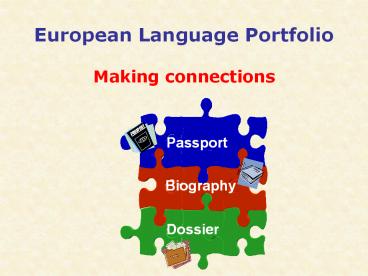European Language Portfolio - PowerPoint PPT Presentation
1 / 13
Title:
European Language Portfolio
Description:
Section 2: The Language Biography. Section 3: The Dossier ... Section 2 : Language and Cultural Biography ... 'My language learning biography' (form #1) ... – PowerPoint PPT presentation
Number of Views:684
Avg rating:3.0/5.0
Title: European Language Portfolio
1
European Language Portfolio
- Making connections
Passport
Biography
Dossier
2
- WHAT IS IT?
- The PORTFOLIO is
- Personal and life-long
- A unique history of your language learning and
intercultural experiences in - Informal situations
- As well as Formal educational settings.
- An internationally recognized standard enabling
- people of all ages and backgrounds in Europe
- to demonstrate their experiences and capabilities
3
- WHY USE IT?
- It is a valuable tool when
- Looking for a job
- Applying to universities or other educational
institutions - Enrolling in language courses
- Assessing your language skills
- Reflecting on your past learning and cultural
experiences - Planning and evaluating your learning progress
more effectively - Becoming aware of and preparing for your future
learning needs
4
The development of the portfolio was supported
by the Council of Europes Language Policy
Division. It is a practical application of the
'Common European Framework of Reference for
Languages'.HOW TO USE IT? It is designed to be
regularly updated by the learner and contains 3
color-coded sections Section 1 The Language
Passport ? Section 2 The Language
Biography ?? Section 3 The Dossier ???
5
Section 1 Language Passport Here you
document and summarize your formal and informal
language experiences by completing the
following a) Self-Assessment Grid to help
you complete your Profile of Language Skills.
This assessment scale (A1, A2, B1, B2, C1,
C2) developed by the Council of Europe provides
all Europeans with a common set of standards.
6
- b) Summary of language learning and
intercultural - experiences
- This allows you to summarize any language
courses, mobility stays or use of a language for
work or study purposes in a format that is
easily interpreted and accessible to interested
parties, e.g. employers, authorities, teachers,
etc.
7
c) Certificates and Diplomas
This form allows you to document all your
formal qualifications
8
- Section 2 Language and Cultural Biography
- Here you record your personal language and
intercultural experiences by completing the
following - My language learning biography (form 1)
- To reflect on your personal experiences,
capabilities, and goals. - To evaluate your personal history of language
learning - To draw conclusions about your particular
learning style and needs
9
- b) My significant intercultural experiences
(form 2) - To explain your personal intercultural background
and experiences
10
- c) Self-Assessment Checklist(3.1-3.6) My
objectives (4) - To discover what you can already do
- To set your future objectives
11
- d) My learning journal (form 5)
- To construct an on-going step-by-step
- evaluation and progress report
12
- Section 3 Dossier for Presentation
- This section allows you to
- Compile and insert various examples of work you
have done or are presently doing to demonstrate
your capabilities and your progress in the
target language(s). - Adapt your samples to a specific situation, e.g.
applying for a job, or changing university.
13
- To learn more
- You can visit the Council of Europes
- website at
- http//www.coe.int./portfolio































